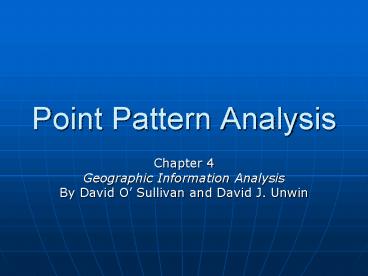Point Pattern Analysis - PowerPoint PPT Presentation
1 / 19
Title:
Point Pattern Analysis
Description:
Hot-spot analysis (crime, disease) -Vegetation, archaeological studies ... Descriptive statistics to provide summary descriptions of point patterns -Mean center ... – PowerPoint PPT presentation
Number of Views:136
Avg rating:3.0/5.0
Title: Point Pattern Analysis
1
Point Pattern Analysis
- Chapter 4
- Geographic Information Analysis
- By David O Sullivan and David J. Unwin
2
Introduction to Point Pattern Analysis
- Simplest Possible Spatial Data
- -A point pattern is a set of events in a study
region - -Each event is symbolized by a point object
- -Data are the locations of a set of point
objects - Applications
- -Hot-spot analysis (crime, disease)
- -Vegetation, archaeological studies
3
Introduction to Point Pattern Analysis
- Requirements for a set of events to constitute a
point pattern - -Pattern should be mapped on a plane
- -Study area determined objectively
- -Pattern is a census of the entities of
interest - -One-to-one correspondence between objects and
- events
- -Event locations are proper
4
Introduction to Point Pattern Analysis
- Describing a point pattern
- Point Density
- -First-order effect Variation
- of intensity of a process
- across space
- -Number of events per unit
- area
- -Absolute location
- Point Separation
- -Second-order effect
- Interaction between
- locations based on distance
- between them
- -Relative location
5
Introduction to Point Pattern Analysis
- Descriptive statistics to provide summary
descriptions of point patterns - -Mean center
- -Standard Distance
6
Density-Based Point Pattern Measures
- First-order effect
- Sensitive to the definition of the study area
7
Density-Based Point Pattern Measures
- Quadrant count methods
- -Record number of events of a pattern in a set
of - cells of a fixed size
- -Census vs. Random
8
Density-Based Point Pattern Measures
- Kernel-density estimation
- -Pattern has a density at any location in the
study - region
- -Good for hot-spot analysis, checking
first-order - stationary process, and linking point
objects to - other geographic data
- Naive method
9
Distance-Based Point Pattern Measures
- Second-order effect
- Nearest-neighbor distance
- -The distance from an event to the nearest
event in - the point pattern
- Mean nearest-neighbor distance
- -Summarizes all the nearest-neighbor distances
by a - single mean value
- -Throws away much of the information about the
- pattern
10
Distance-Based Point Pattern Measures
- G function
- -Simplest
- -Examines the cumulative frequency distribution
of - the nearest-neighbor distances
- -The value of G for any distance tells you what
- fraction of all the nearest-neighbor
distances in the - pattern are less than that distance
11
Distance-Based Point Pattern Measures
- F function
- -Point locations are selected at random in the
study - region and minimum distance from point
location to - event is determined
- -The F function is the cumulative frequency
- distribution
- -Advantage over G function Increased sample
size - for smoother curve
12
Distance-Based Point Pattern Measures
- K function
- -Based on all distances between events
- -Provides the most information about the
pattern
13
Distance-Based Point Pattern Measures
- Problem with all distance functions are edge
effects - Solution is to implement a guard zone
14
Assessing Point Patterns Statistically
- Null hypothesis
- -A particular spatial process produced the
observed - pattern (IRP/CSR)
- Sample
- -A set of spatial data from the set of all
possible - realizations of the hypothesized
process - Testing
- -Using a test to illustrate how probable an
observed - value of a pattern is relative to the
distribution of values - in a sampling distribution
15
Assessing Point Patterns Statistically
16
Assessing Point Patterns Statistically
- Quadrant counts
- -Probability distribution for a quadrant count
- description of a point pattern is
given by a Poisson - distribution
- -Null hypothesis (IRP/CSR)
- -Test statistic Intensity (?)
- -Tests Variance/mean ratio, Chi-square
- Nearest-neighbor distances
- -R statistic
17
Assessing Point Patterns Statistically
- G and F functions
- -Plot observed pattern and IRP/CSR pattern
18
Assessing Point Patterns Statistically
- K function
- -Difficult to see small differences between
expected - and observed patterns when plotted
- -Develop another function L(d) that should
equal - zero if K(d) is IRP/CSR
- -Use computer simulations to generate IRP/CSR
- (Monte Carlo procedure)
19
Critiques of Spatial Statistical Analysis
- Peter Gould
- -Geographical data sets are not samples
- -Geographical data are not random
- -Geographical data are not independent random
- -n is always large so results are almost always
- statistically significant
- -A null hypothesis of IRP/CSR being rejected
means - any other process is the alternative
hypothesis - David Harvey
- -Altering parameter estimates by changing study
- region size often can alter conclusions































